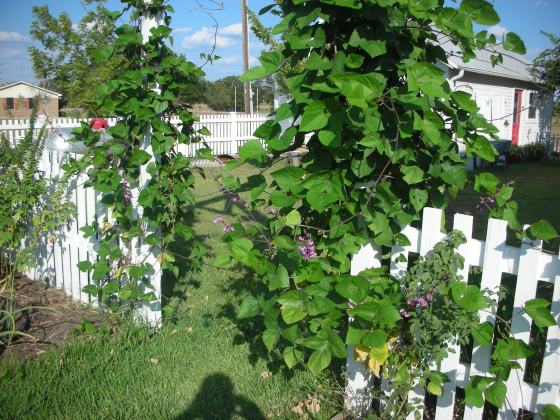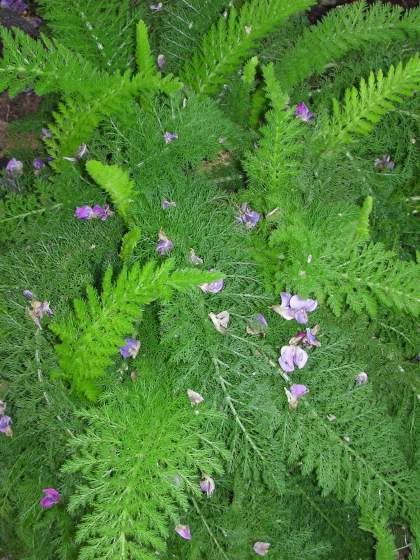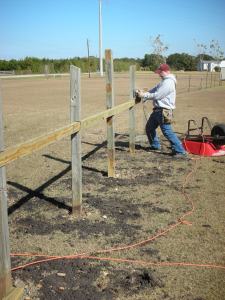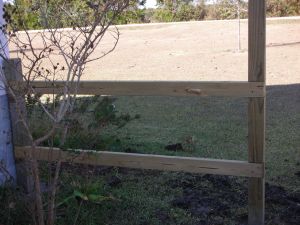
The yupneck leveling a post for the picket fence
I started this blog as a way to share some of the things I am learning as I pursue my Master’s degree in Horticulture at Texas A&M (Whoop!) with my fellow gardeners. What started out as fun is slowly turning into a new side line for me; garden writing. So far, four of the articles that are contained on this site have been published. This has been a very exciting and fun diversion for me. Once I stated getting published, it kind of changed the way I look at just about everything I do in the garden and around the house. Now, instead of just taking cuttings from my coleus like I always have, I have to stop whatever I am doing and go find a camera so I can document it for an article!
This post is a classic example. I am in the process of building a picket fence around my house. In my “pre-writer” days, I would have just built the fence, taken a picture or two to show my friends and family, and then moved on to my next project. Not anymore. Now, each project has to be “documented”. So, this post will document the “beginnings” of the picket fence project. All of this picture taking is driving my wife a little nuts but she is going along with it for now.
I don’t know if I have mentioned it or not, but my wife and I are remodeling an old farmhouse. One of the projects that we planned to do was build a picket fence around the place. This was pretty low on the priority list (way behind getting central heat and air, a new kitchen and a new bathroom) until two weeks ago.

Who would throw this out?
Two weeks ago, the fence took on a whole new level of importance when we picked up a beautiful Australian Shepherd out of the middle of the road. Someone had “dumped her” in our neck of the woods. At first, we figure she was lost. She was so pretty and wearing a collar. Who would dump such a fine animal? So, thinking she was lost, we took her in and set out to find her owner. Well, no owner came forward and we slowly began to accept the fact that we had inherited a dog. Now normal people that do not have the means to keep a dog would simply not keep her. However, I am proud to say my wife and I are not normal. Instead of taking her to the pound, we decided to build a fence!
As luck would have it, my neighbor had just taken down a lovely two board fence that ran across the front of his property. Since the yupneck is too cheap to buy new, I bought the used 4X4 posts and the runners from him. He also owns a bobcat set up as a post hole digger. So, for a very few dollars, I got most of the materials for the fence and someone to save my back from the hours of manual post hole digging.

My neighbor's post hole digging machine
Alan showed up at 7:15 last Sunday and drilled all of my post holes. It took him 20 minutes to drill 17 holes. It would have taken me 20 minutes to dig a single hole. Over the past week, Sally and I have cleaned out the holes, filled the bottoms with brick bats and started cementing the posts in. We finished this Sunday right after church. If you notice in the pictures, we are still wearing our church clothes (like I said before, we are not completely normal)!
I am very excited that this project is under way. I have wanted a picket fence for quite some time. No, let me restate that. I have NEEDED the fence for quite some. You see, as this blog is supposed to highlight, I am a gardener. Because of this, I have completely filled up all of the beds around my house. This fence will allow me to create literally hundreds of more feet of beds! Also, who has ever closed their eyes and envisioned an antique farmhouse in the country that didn’t have a picket fence? No one, that’s who! Old farmhouses are required to have picket fences covered in old roses (one of which we bought at the Antique Rose Emporium this weekend) and surrounded by beds full of things your grand mother grew. That is what this fence will do for me. It will complete the dream!

Setting posts in our church clothes
I hope to have the first section of fence completed by Thanksgiving. My birthday is pretty close to Thanksgiving this year and I have asked all five kids to come celebrate by throwing me a painting party. If all goes well, we will have the fence and the garage painted by the end of next weekend. Check back to see how it goes.
P.S. If you would like detailed instructions on how I build a picket fence, email me or leave a comment and I will post everything you need to know.






















